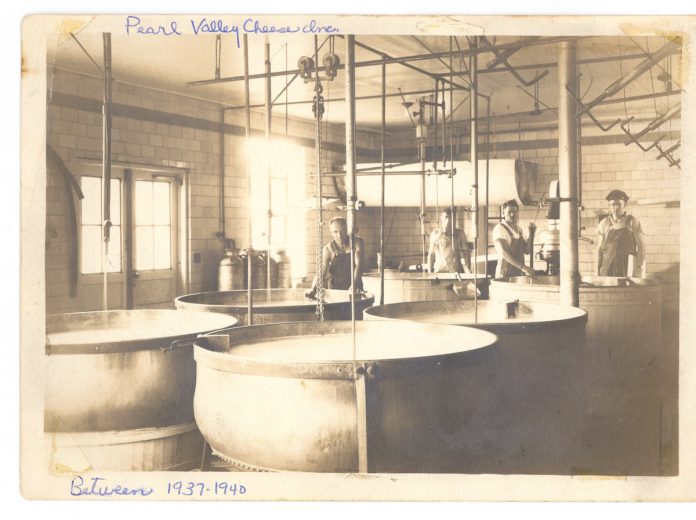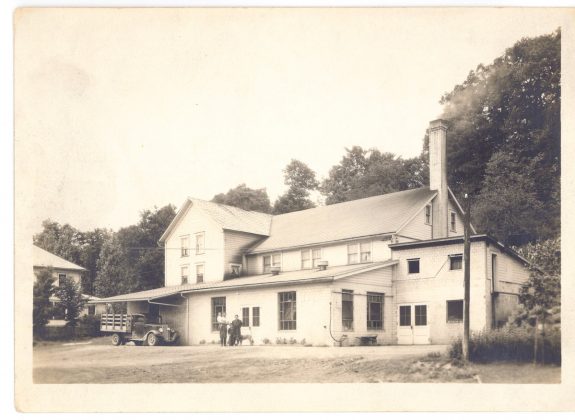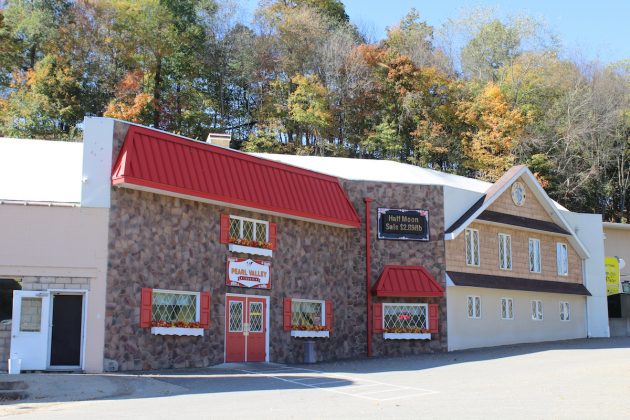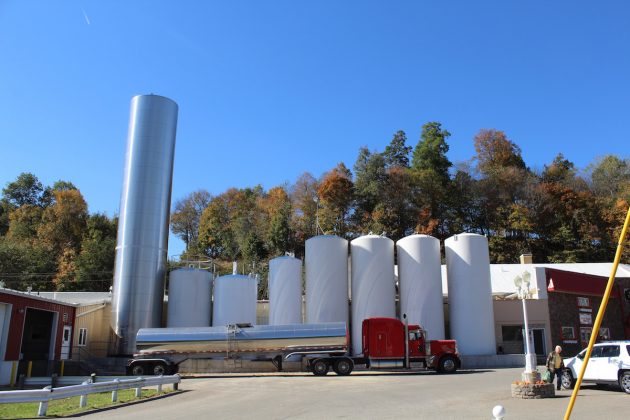
FRESNO, Ohio — Swiss cheese making in Ohio is almost as old as the state itself. Congress granted Ohio statehood in 1803. Thirty years later, it’s said that the first batch of Swiss cheese was made in a copper kettle in the Ragersville area.
That was just the beginning of Ohio’s shared history with Swiss cheese and Swiss culture.
The state produced 45% of the nation’s Swiss cheese last year, and over 60% of cheese produced in Ohio is Swiss. That level of production came from 12 plants, many of them in southeastern Ohio’s rolling hills.
“The old timers used to say you can’t make good Swiss cheese from milk from the flatlands,” said Richard Guggisberg, president of Guggisberg Cheese, in Millersburg, Ohio.
That’s why it’s bittersweet that after more than 100 years of supporting the state’s Swiss cheese industry, the Ohio Swiss Cheese Association is no more. The group dissolved this year, after several years of waning membership and interest. The dissolution was announced publicly in September.
What happened to the Swiss cheese association is a reflection of what’s happening all over agriculture and, in particular, the dairy industry. Smaller producers have gone out of business, leaving fewer, larger plants.
The association formed in 1918 to help Ohio’s Swiss cheese makers produce a safer and better quality product. It grew to host a series of contests to judge and recognize the state’s best Swiss cheese maker and to promote the cheese and Swiss culture at the annual Ohio Swiss Festival.
“In the ’80s, there’d be 12 or 14 plants bringing cheese for judging,” said Chuck Ellis, president of the association and president of Pearl Valley Cheese, in Fresno, Ohio. “As companies shut down or left, it was us and Guggisberg cheese doing the contests.”
STARTING SMALL
The Swiss cheese industry in eastern Ohio grew through the 19th century, with the influx of Swiss immigrant families. The early epicenter of Swiss cheese production was in Tuscarawas County, but cheese houses popped up throughout Holmes, Coshocton, Wayne and Stark counties, according to the book, Ohio Swiss Cheese Association: 100 Years of Swiss Cheese and Swiss Culture.
Cheese house wasn’t an expression. Many Swiss cheesemakers would build living quarters on top of the cheese plant. It was a necessary living combination. Making Swiss cheese at the time was time and labor intensive.
Makers started their days early, starting fires while waiting for milk to be delivered from that morning’s milking. Milk was heated in large copper kettles that held up to 300 gallons of milk. A kettle that size would yield a 200-pound cheese wheel, Ellis said. The process would be repeated again, after the evening milking.
Guggisberg grew up in one of these cheese houses in Doughty Valley, in Millersburg, Ohio. His father, Alfred, founded the company in 1950, only a few years after he emigrated to the U.S.
Some of his earliest memories are of an old, retired cheesemaker going into the cooler in the basement to grade cheese wheels, Guggisberg said. Cheese was graded A for the best, then B, C and grinder for the lowest quality cheese.
“He’d always have a cigar in his mouth,” he said. “I’d be playing in the kitchen and smell that cigar smoke. Then I’d hear his gruff voice call out the grades.”
The Guggisberg cheese plant had four copper kettles as Richard grew up. They expanded to eight kettles, then to stainless steel vats. In the late ’60s, Richard’s father developed a new type of cheese — baby Swiss — a softer, creamier and milder tasting cheese. That cheese was the key to the company’s growth and success through the following decades.
When Alfred Guggisberg passed away in 1985, Richard took over the company. Guggisberg raised his family in the same house he grew up in for the first eight years of his marriage. They lived above the cheese plant until 1994.
“My wife got used to waking up to the sound of the milk truck driver, the clanging of the lids coming off of the milk trucks,” he said. “That was the noise she got used to, and she kind of missed it when we built our own house and moved across the street.”
BE CONSISTENT
By the turn of the 20th century, the number of cheesemakers was at an all-time high. According to the Ohio Swiss Cheese Association book, there were 137 producers in 1908. But the industry was volatile and makers came and went.
Though cheese makers were plentiful, there was little consistency to the product. That made it difficult to market outside the region. The number of producers dropped to 63 by 1914.
“Back in the day, you made the cheese with the natural cultures that were there,” Guggisberg said. “Then you kept the whey for starter for the next day.”
There isn’t anything technically wrong with doing it this way, he said, but you never knew what sort of product you’d get.
“That could be erratic. There wasn’t much consistency,” Guggisberg said.
A group of cheesemakers got together and approached Ohio State University and the U.S. Department of Agriculture to get help with their quality issues. That’s how the Ohio Swiss Cheese Association was born.
There were small, mostly family-owned and run plants scattered around the area. None of them had the time or money for their own laboratory or a research and development department. A lab was built at Sugarcreek Dairy Co. and staffed with scientists from the USDA, who worked on developing a starter culture that could be used by cheesemakers to guarantee the same product each time.
The development of a starter culture was a game-changer. The first two companies to use the association’s culture saw an improvement of their quality and began receiving a higher price per pound for their cheese.
“That drastically improved the quality of the Swiss,” Guggisberg said.
As time went on, the role of the association changed along with the industry. In addition to the central lab in Sugarcreek, a mobile lab traveled around the area to conduct testing and research. The association also doubled as a supply house for area cheesemakers.
As the group grew, it held an annual conference and began hosting contests. In 1953, the group organized the first Ohio Swiss Festival in Sugarcreek. The event was to be a way to promote the local cheese industry and the area’s tourism industry.
The first year, 28 cheesemakers sold more than three tons of Swiss cheese at the festival. The following year, the amount of cheese sold doubled.
When Ellis came into the picture in the 1980s, there were still some first generation Swiss cheese makers around. Ellis married into Swiss cheese. His wife, Sally, is the third generation of the Stalder family, which bought Pearl Valley Cheese in 1928.
The contests were as much about competition and bragging rights as the camaraderie, Ellis said. The group would often convene at a local tavern or restaurant after the grand champion was announced.
“If you won the contest, the expectation was that you’d buy the beer and burgers for the rest of the group,” Ellis said.
As the night went on, after the drinks had been flowing, Ellis said some of the old Swiss guys might start yodeling.
CHANGING TIMES
The days of laboring all day over a fire to make a couple wheels of cheese are over. Stainless steel vats replaced copper kettles. Milk trucks replaced milk cans. To stay in business, you not only have to make a consistent product, which is what the association helped with at the start, but you need to do it safely and in line with the increasingly strict regulations, Guggisberg said.
In that same vein, much of the process to make Swiss cheese is automated now. That was a good thing when the pandemic hit last year and it became a struggle to find and keep healthy employees, Guggisberg said.
“We thank God that we went into the degree of automation that we did, because finding people to do labor intensive work and do it well is hard,” Guggisberg said.
The association dropped to just a handful of members in the last decade. The Swiss Cheese Association book recognized Guggisberg Cheese, Pearl Valley Cheese, Steiner Dairy, Broad Run Cheese, Middlefield Original Cheese Co-op and Bunker Hill Cheese as members in 2018.
Ellis said they saw the end coming in the last couple years. With so few competitors, the contest didn’t have much purpose anymore. As they discussed ending the contest, they also evaluated the purpose of the association.

“Most of it had to do with the contest and promoting the association at the Swiss Festival,” Ellis said.
Much of what the association used to do — quality control testing and research, advocacy and promotion — the large individual cheese companies now did themselves.
Though the association is gone, the industry it supported is in good hands. The Ohio Swiss cheese makers are competing now on a larger stage, both in terms of sales and national recognition. Pearl Valley makes 14 types of cheese, including four varieties of Swiss, that are distributed wholesale across the country. The plant in Fresno, Ohio, makes 6 million pounds of cheese per year.
Guggisberg too makes 14 varieties of cheese now, including its Swiss varieties. The company took the title of U.S. Grand Champion cheese in 2019 for its baby Swiss.
“It feels good,” Guggisberg said. “It feels good for our employees. It feels good for people who ship their milk here. I’ve had several farmers that have said, ‘I’m proud to ship my milk to you.’ To hear that, it still means a lot.”
(Reporter Rachel Wagoner can be contacted at 800-837-3419 or rachel@farmanddairy.com.)
















